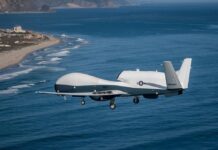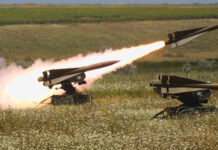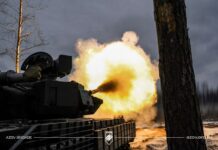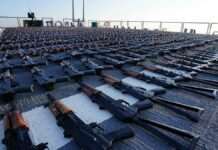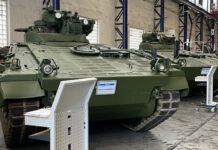Russia launched a major missile attack against Ukraine on 9 March 2023 on a scale rarely seen previously. Most notably the attack included the use of six Kh-47M2 Kinzhal air-launched ballistic missiles: almost certainly the highest number of Kinzhals Russia has used against Ukraine in any such barrage.
“During the day of March 9 the enemy launched a total of 84 missiles of various types,” the Ukrainian government posted on its website that evening. “Thirty-four missiles were destroyed by Ukrainian defenders, another eight did not hit their targets. The enemy also launched 12 air strikes, in particular employing eight Shahed-136 [unmanned aerial vehicles]. Half of them were shot down.
“The level of missile threat across Ukraine remains high.”
Ukrainian Air Force (Povitryani Syly Ukrayiny – PSU) spokesman Yurii Ihnat was quoted as saying on Ukrainian TV on 9 March, “The attack is really large scale and for the first time using such different types of missiles. We see that this time as many as six Kinzhals were used. This is an attack like I don’t remember seeing before.”
The Russian attack clearly targeted Ukraine’s utilities infrastructure, leaving half a million people without power in the city of Kharkiv alone. Ukrainian President Volodymyr Zelensky stated on the Ukrainian Ministry of Defence website on 9 March, “Kharkiv and the Zhytomyr region have the most difficult situation. Odesa, the Dnipropetrovsk region, Kyiv and Zaporizhzhia are also facing difficulties.”
The attack also led to a loss of power at the Zaporizhzhia nuclear power plant, forcing it to rely on diesel generators for the electricity needed to cool radioactive material for the sixth time since the Ukraine conflict began. The power plant, which is under Russian control but manned mostly by Ukrainians, is the source of much concern from the International Atomic Energy Agency, which fears a disaster at what is the largest nuclear power station in Europe.

Moscow’s claimed reason for its latest large-scale missile attack on Ukraine was retaliation for “terrorist actions” conducted across Russia’s border into the Bryansk region on 2 March: an incursion made by a pro-Ukrainian Russian nationalist militia called the Russian Volunteer Corps.
However, the wider strategy of such missile barrages is unclear. The targeting of Ukraine’s civilian infrastructure, while it heaps further misery and casualties on the Ukrainian people, serves little military purpose and mostly likely galvanises public support for Zelensky’s goal of a complete ousting of Russian forces from all Ukrainian territory. The Ukrainians have also become quite adept at repairing the damage: US broadcaster VOA quoted Serhii Popko, head of Kyiv’s military administration, as saying that power and water had been restored in the city on 10 March while 30% of residents remained without heating. Electricity was 90% restored in Ukraine’s northeastern Kharkiv region, VOA reported local officials as saying, while power was also restored to a third of consumers in Ukraine’s southern Zaporizhzhia region.
Asked to comment on Moscow’s aims with such attacks, Professor Mark Galeotti, Honorary Professor at the UCL School of Slavonic & East European Studies in London and a specialist in Russian military politics, told ESD, “I think the overall strategy is political: trying to demonstrate to both Kyiv and the West that Russia is still very much in the game.”
Galeotti characterised the overall situation in Ukraine as “in many ways a game of geopolitical chicken in which both Moscow and the West are trying to project a greater willingness and ability to outlast the other”.
One possible reason for Russia to employ Kinzhal ballistic missiles is that their hypersonic speed can defeat Ukraine’s air defences. PSU spokesman Ihnat, referring to the Kinzhals as well as Russia’s use of Kh-22 air-launched cruise missiles (ostensibly anti-ship weapons), conceded that, “So far, we have no capabilities to counter these weapons.”
Use of the Kh-47M2 could also be seen as a form of intimidation in relation to Ukraine’s Western allies, as it is viewed by Moscow as one of Russia’s latest prestige weapon systems.
Galeotti, meanwhile, offered another possible reason for Russia to have expended some of its Kh-47M2s. “I think the use of the Kinzhal,” he suggested, “may also have been intended to counter claims that Russia was running low on its more sophisticated and precision weapons: ‘See? We’ve so many we could burn six in one night’s bombardment!’”

A 10 March update on the Ukraine conflict by the UK Defence Intelligence (DI) organisation noted that the intervals between major Russian missile strikes on Ukraine are growing. This, DI suggested, is “probably … because Russia now needs to stockpile a critical mass of newly produced missiles directly from industry before it can resource a strike big enough to credibly overwhelm Ukrainian air defences”.
A year’s-worth of the Russian offensive in Ukraine, along with Russian air operations over Syria from 2015 to 2018 in support of the Assad regime, have clearly demonstrated that Russia’s precision strike capabilities are – apart from a small number of systems like the Kinzhal – considerably lacking. Indeed, there is an argument to be made that Russia is targeting Ukrainian infrastructure precisely because it is unable to effectively prosecute attacks against military targets.
Ukraine’s forces, on the other hand, are increasingly armed with sophisticated and highly accurate Western weaponry. This creates an overmatch in capability that, combined with the Ukrainian military’s significantly higher motivation, could help the Ukrainian operate more offensively and take back territory while Russian missiles continue to pound Ukrainian cities to cause further suffering but no military advantage.
Peter Felstead






